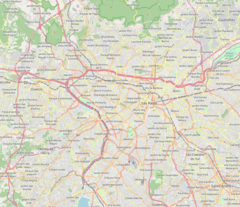Sala São Paulo
| Sala São Paulo | |
|---|---|
| Centro Cultural Júlio Prestes | |

Interior of Sala São Paulo
|
|
| General information | |
| Type | Concert hall |
| Architectural style |
Necoclassical Louis XVI style |
| Location | Júlio Prestes Square, 16, Campos Elíseos, São Paulo. |
| Coordinates | 23°32′3″S 46°38′23″W / 23.53417°S 46.63972°WCoordinates: 23°32′3″S 46°38′23″W / 23.53417°S 46.63972°W |
| Elevation | 24 meters. |
| Completed | 1938 (main building) |
| Inaugurated | 9 July 1999 (concert hall) |
| Technical details | |
| Floor area | 10,000 m2 (110,000 sq ft) |
| Design and construction | |
| Architect | Cristiano Stockler das Neves |
| Other information | |
| Seating capacity | 1500 |
The Júlio Prestes Cultural Center, which is located in the Júlio Prestes Train Station in the old north central section of the city of São Paulo, Brazil, was inaugurated on July 9, 1999. The building has been totally restored and renovated by the São Paulo State Government, as part of the downtown revitalization in that city. It houses the Sala São Paulo, which has a capacity of 1498 seats and is the home of the São Paulo State Symphonic Orchestra (OSESP). It is a venue for symphonic and chamber presentations and has been designed according to state of the art standards, comparable to the Boston Symphony Hall, Musikverein in Vienna and the Concertgebouw in Amsterdam.
Renovation began in November 1997, but the first steps were taken in 1995. Governor Mario Covas visualized the Julio Prestes space as ideal for symphonic presentations and because OSESP did not have a permanent home.
Julio Prestes Station was built between 1926 and 1938 to be the headquarters and departure point of the Sorocabana Railway (EFS) - a company set up by coffee barons to ship the product from the SW of São Paulo State and Parana' State to the port of Santos. The state of São Paulo acquired the EFS in 1905 and its name was changed to Ferrovia Paulista S/A or FEPASA in the 1970s. After the 1929 New York Exchange crash and recession that followed, the São Paulo coffee stock market declined in importance. With industrialization and the advent of the car industry and the excellent São Paulo State road network, mass transportation switched to state of the art buses and automobiles. The FEPASA line, which had become infamous for lateness & technical problems, was finally replaced by the automobile and most stations closed their doors to passenger transportation between SW towns and the state capital.
From the 1980s on the Companhia de Trens Metropolitanos - CPTM - took over the line, operating only in the metropolitan area and municipalities in the Greater São Paulo region. The name Julio Prestes honors an ex-railwayman who was governor of São Paulo and a presidential candidate to Brazil. The architect who planned JP, Christiano Stockler das Neves, based his project on an eclectic style, described as neo classical Louis XVI which was a reaction to the overornate baroque style. He was also clearly influenced by the old Pennsylvania station in New York, which was demolished to give way to the building of the Madison Square Garden. While it was being built in the 1920s, the Grand Hall, where the concert hall is today, had a small railway in the middle of the construction work. Thus, imported material from Europe could be easily brought in.
...
Wikipedia


